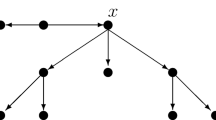Abstract
A vertex subset S of a digraph D is called a dominating set of D if every vertex not in S is adjacent from at least one vertex in S. The domination number of D, denoted by \(\gamma (D)\), is the minimum cardinality of a dominating set of D. The Slater number \(s\ell (D)\) is the smallest integer t such that t added to the sum of the first t terms of the non-increasing out-degree sequence of D is at least as large as the order of D. For any digraph D of order n with maximum out-degree \(\Delta ^+\), it is known that \(\gamma (D)\ge \lceil n/(\Delta ^++1)\rceil \). We show that \(\gamma (D)\ge s\ell (D)\ge \lceil n/(\Delta ^++1)\rceil \) and the difference between \(s\ell (D)\) and \(\lceil n/(\Delta ^++1)\rceil \) can be arbitrarily large. In particular, for an oriented tree T of order n with \(n_0\) vertices of out-degree 0, we show that \((n-n_0+1)/2\le s\ell (T)\le \gamma (T)\le 2s\ell (T)-1\) and moreover, each value between the lower bound \(s\ell (T)\) and the upper bound \(2s\ell (T)-1\) is attainable by \(\gamma (T)\) for some oriented trees. Further, we characterize the oriented trees T for which \(s\ell (T)=(n-n_0+1)/2\) hold and show that the difference between \(s\ell (T)\) and \((n-n_0+1)/2\) can be arbitrarily large. Some other elementary properties involving the Slater number are also presented.

Similar content being viewed by others
References
Ahangar HA, Henning MA, Löwenstein C, Zhao Y, Samodivkin V (2014) Signed Roman domination in graphs. J Comb Optim 27:241–255
Butenko S, Anderoglu SK, Ursulenko O (2011) On connected domination in unit ball graphs. Optim Lett 5:195–205
Caro Y, Henning MA (2012) Directed domination in oriented graphs. Discrete Appl Math 160:1053–1063
Crevals S, Östergard PRJ (2015) Independent domination of grids. Discrete Math 338:1379–1384
Dehgardi N, Sheikholeslami SM, Khodkar A (2014) Bounding the paired-domination number of a tree in terms of its annihilation number. Filomat 28:523–529
Desormeaux WJ, Haynes TW, Henning MA (2014a) Improved bounds on the domination number of a tree. Discrete Appl Math 177:88–94
Desormeaux WJ, Haynes TW, Henning MA, Yeo A (2014b) Total domination in graphs with diameter 2. J Graph Theory 75:91–103
Fu Y (1968) Dominating set and converse dominating set of a directed graph. Am Math Mon 75:861–863
Hao G, Qian J (2015) On the sum of out-domination number and in-domination number of digraphs. Ars Comb 119:331–337
Haynes TW, Hedetniemi ST, Slater PJ (1998) Domination in graphs: advanced topics. Marcel Dekker Inc, New York
Koltun V, Papadimitriou CH (2007) Approximately dominating representatives. Theor Comput Sci 371:148–154
Lee C (1998) Domination in digraphs. J Korean Math Soc 35:843–853
Shan EF, Cheng TCE, Kang LY (2007) Absorbant of generalized de Bruijn digraphs. Inf Process Lett 105:6–11
Slater PJ (1995) Locating dominating sets and locating-dominating sets. In: Alavi Y, Schwenk A (eds) Graph theory, combinatorics, and applications, proceedings of the seventh quadrennial international conference on the theory and applications of graphs. Wiley, Hoboken, pp 1073–1079
Volkmann L (2015) Signed total Roman domination in graphs. J Comb Optim. doi:10.1007/s10878-015-9906-6
Wu J (2002) Extended dominating-set-based routing in ad hoc wireless networks with unidirectional links. IEEE Trans Parallel Distrib Syst 13:866–881
Acknowledgements
This work was supported by NSFC (No. 11471273), the Research Foundation of Education Bureau of Jiangxi Province of China (No. GJJ150561) and the Doctor Fund of East China University of Technology (No. DHBK2015319).
Author information
Authors and Affiliations
Corresponding author
Rights and permissions
About this article
Cite this article
Hao, G., Qian, J. Bounds on the domination number of a digraph. J Comb Optim 35, 64–74 (2018). https://doi.org/10.1007/s10878-017-0154-9
Published:
Issue Date:
DOI: https://doi.org/10.1007/s10878-017-0154-9



